Ryan Hall's Blog, page 345
September 29, 2015
Video: 4 Random Runners Cheered Relentlessly at Rock ‘n’ Roll Montreal

Here’s a great pick-me-up video for you—at the Rock ‘n’ Roll Montreal Oasis Marathon earlier this month, four runners were picked at random and turned into rock stars. They had dedicated fans follow them along the half-marathon course, cheering and encouraging their efforts, and in some cases even taking things even further. Along the course, 12 hidden cameras captured the fun.
The plan was carried out by Oasis, the title sponsor of Rock ‘n’ Roll Montreal.
RELATED: Photos: Rock ‘n’ Roll Montreal
The post Video: 4 Random Runners Cheered Relentlessly at Rock ‘n’ Roll Montreal appeared first on Competitor.com.
September 28, 2015
Listen: A Roundtable on Running Shoe Innovation
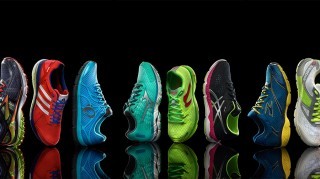
The Science Friday podcast recently explored the evolution of sneakers, touching on the innovation of traction, shoe weight and more. They also talk to noted biomechanist Rodger Kram on the difference between running in cushioned shoes and barefoot running, while also talking about the future of sneakers and how 3D printing could factor how our shoes will look.
You can listen to the whole episode here:
The post Listen: A Roundtable on Running Shoe Innovation appeared first on Competitor.com.
5 Race Day Don’ts For Runners
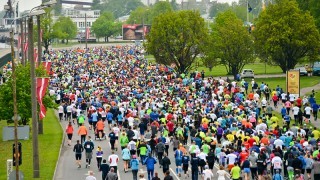
Photo: Shutterstock.com
Race morning is typically a time when your nerves are on edge. A good way to ensure you’re as prepared as possible is to know what not to do from the time you wake up to the moment when the gun sounds.
Keep these five “don’ts” in mind next time you’re getting ready to take the start line:
1. Don’t starve yourself.
Coach Dennis Barker of Team USA Minnesota suggests setting your alarm for about four hours prior to the start of your race so that you can have a light breakfast. “For a longer race, where glycogen depletion may be an issue, remember that while your muscle glycogen remains constant overnight, the glycogen in your liver is depleted even while sleeping,” he says. Alicia Shay, an Olympic Trials qualifier, internationally competitive trail runner and coach, agrees that proper fueling is key the morning of and suggests practicing in training what you will eat on race day. “You will want to know that those foods don’t upset your stomach,” she cautions.
2. Don’t start the race with cold legs.
Even if you’re running a marathon, do some sort of warm-up before the race. “Your warm-up is a time to prepare both your body and mind for your best effort,” says Barker. “While you’re jogging, doing drills and stretching, think about your race strategy and how you will execute it. You have probably already thought about it, but think about it again and commit to it.” Go to the line confident in your plan with determination to execute it, and be prepared to react positively to situations you can’t control.
3. Don’t forget a race-day plan.
Heather North, coach of Revolution Running says that your race-day plan should include figuring out the time you need to get up, knowing exactly where to park, understanding the best way to get to the start line or your corral and allowing plenty of time to warm-up. “Race morning can turn into a stressful disaster if you haven’t allowed those extra 15-30 minutes to get everything in,” she says. Also remember that races can be chaotic affairs, so come into it with a flexible mind and expect that change will be the norm. Barker points out that race management, course, and organization can change. Another thing that can change is the weather, so in your race-day plan, make sure you’re packing some cold, windy and hot-weather apparel options in the event that the race-day forecast is wrong.
4. Don’t abstain from coffee and water.
The last thing you need to worry about is a caffeine headache halfway through your race. If your body is used to it, it may not feel the same without it. Barker advises limiting your pre-race coffee consumption to one small cup. “You want to receive the benefits without getting too jacked up or having to go to the bathroom too much,” he says. Barker also recommends alternating between coffee and small amounts of water and/or a trusted sports drink that you’ve consumed in training. Don’t overdo it with the fluids. You want to be hydrated—not overhydrated.
5. Remember why you’re out there in the first place.
Sure, you’ve put a lot of time and effort into training for the race, but remember, this is supposed to be fun! “Many runners are so focused on race morning and the results of everything that they forget to enjoy the day,” says North. “This has been a process of many workouts, long runs, sweat and sacrifice. Relish in the journey that has taken you so many miles. Enjoy the scenery, listen to the sounds and take in each experience along the way. It is a blessing to be able to run, so soak it in!” Shay concurs, saying, “Running and racing is a wonderful gift and nothing that should cause too much anxiety.”
RElATED: Tapering Dos and Don’ts For Marathoners
The post 5 Race Day Don’ts For Runners appeared first on Competitor.com.
Overcoming the Myths of Ultrarunning
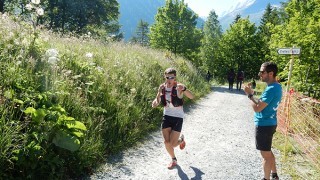
Photo: Brian Metzler
Whenever we try something new we always have some preconceived notion or misconception of what that new experience might entail. Those are myths, and plenty of them abound when you reach the point where you might want to try your first ultramarathon.
First off, the word ultramarathon makes it seem like an unreasonable task for anyone of regular human ability. Let me assure you that isn’t the case. An ultramarathon is any race longer than 26.2 miles, whether it’s on roads, the trails or up over a mountain. Last year, an estimated 100,000 people ran an ultra in the U.S. alone. That doesn’t include the 22,000 people that ran this year’s Comrades Marathon (90K) in South Africa or the thousands of other ultra-distance races around the world.
There are also some trail races that are shorter than 26.2 miles but nevertheless will take you what feels like an eternity to finish. These are called mountain races and should be grouped in the ultramarathon category due to the absurd amount of time that it can take to reach a high peak—at least that’s what it feels like. Treat mountain races like ultras. I’ve found that out the hard way.
Here are a few tips that will hopefully help quell that desire to run shrieking in the opposite direction the next time your running partner shoves an ultramarathon race registration in your face.
Myth 1: You’ll get slow.
I think this is the single biggest myth cited among young fast guys and gals for not venturing into anything longer than 26 miles. I think by now this has been properly disproven by numerous guys (including myself) who have jumped around from distance to distance. American David Laney, who just finished third at the 167K (or 104-mile) Ultra-Trail du Mont-Blanc in Europe, says he’d been worried about that for years. His credits his strong effort at the UTMB (his third 100-miler) to both his ability to expand his endurance but also maintain his speed. “Within a few months after an epic blow up at Western States in 2014, I was back running mile repeats on the track better than I could have in college,” says Laney, 27, who ran a 2:17:03 marathon PR last December at the California International Marathon.
Myth 2: Ultrarunners “run” the whole way.
If you can, more power to you, but even the best of the best are going to be walking some in an ultra. For many ultrarunners it’s going to involve a lot of walking. “I don’t think people know just how much walking is involved for us slower people and don’t add that into their training” says Joe Trupp, 40, an ultrarunner who manages the Gazelle Sports in Kalamazoo, Mich. When a race involves a significant amount of hiking, it’s important to practice that in training in order to become more efficient at it. Don’t assume you’ll have to “run” the whole distance. Those “walking” sections break up the running and make the distance more manageable.
RELATED: 6 Tips to Get Your Through Your First Ultramarathon Successfully
Myth 3: Ultrarunners are all crazy and “there’s no way I could ever run that far.”
Well, yes. By your normal American standard we are a bit nuts, but the jump from a marathon—which saw over 500,000 people complete one last year—to the 50K distance is, in simple terms, only five more miles. The biggest hurdle for Jonathan Smolin, a 41-year-old ultrarunner from Hanover, N.H., with a Vermont 100 finish to his credit, was getting past that “mental barrier of moving from a marathon to an ultramarathon.” That might sound familiar to a lot of marathoners. “My first ultra was a 100K and, when I ran it, my longest run to that point had been a marathon,” Smolin says. “I remember convincing myself before the race that I could do it, to take it one aid station at a time, and to have fun. And it worked.”
Myth 4: You lose connection with your family and friends.
“I heard you have to give up your friends, your life, and all your free time and run 100+ mile weeks,” says Kari Strang, 42, a recently converted marathoner from Bend, Ore. Just as Smolin had only run up to the marathon distance before completing his first 100K race, completing an ultra doesn’t require you to ditch your whole life and run around in the woods 24 hours a day. A fairly modest training approach that you would use to train for a marathon can properly prepare you to run up to 100 miles. The trick is believing that you can do it and then taking care of yourself during the event through proper nutrition, blister and chafing prevention, etc., to maximize the time your legs and mind will keep you moving forward toward the finish.
RELATED: How to Optimize Your Training Time for Trail Racing
Myth 5: Running that far cannot be good for your joints.
If we’re talking purely about how damaged your legs feel after a race and how long it takes for total recovery afterward, I like to compare a road marathon to a trail 50-miler (or even further distances). Proper training can further minimize muscle and joint damage for both the marathon and ultra distances. The reason an ultra is easier on your body is that most will be on a soft trail or dirt, easing the pounding on the legs. You’ll feel better after a 50K trail race than after a road marathon.
RELATED: What’s Harder On Your Body: Trail Ultras or Road Marathons?
Of course, I would be remiss if we completely ignored running form in this argument, as there are plenty of runners that have experienced joint pain from years of running. Nothing is more important to running longevity than working to improve running form in order to reduce joint stress, and also doing the necessary strength work to stabilize your joints during running.
While there are many myths that persist despite the growth in ultra marathon popularity, making the jump from the marathon is as much a mental barrier than anything else. The best way to dispel those myths is to sign up for that next race your ultra buddy has been harassing you about. Once you believe that you can do it, and don’t mind a few black toenails along the way, the reward is a huge accomplishment and a fun-loving, supportive community of new friends.
RELATED:
— Max King’s 5 Tips for the Trails
— Hit The Dirt—Take Your Workouts to the Trails
****
About The Author:
Salomon Running athlete Max King jumps around from ultras to track races to obstacle races and everything in between. He has yet to lose his speed on the track or any toenails from an ultra. He has has won numerous USATF trail running national titles, as well as the 2011 World Mountain Running Championships and the 2014 IAU 100K World Championships. He can be found at @maxkingOR.
The post Overcoming the Myths of Ultrarunning appeared first on Competitor.com.
Video: Meb Keflezighi After His Masters Record at Rock ‘n’ Roll San Jose

Meb Keflezighi ran a 1:03:02 at the Rock ‘n’ Roll San Jose Half Marathon on Sunday, placing second overall and setting a U.S. Masters record at the half marathon distance. Afterward, he spoke with Competitor senior editor Mario Fraioli about his race, his upcoming calendar, and the competitiveness of the Rock ‘n’ Roll San Jose field.
RELATED: Photos: 2015 Rock ‘n’ Roll San Jose
The post Video: Meb Keflezighi After His Masters Record at Rock ‘n’ Roll San Jose appeared first on Competitor.com.
USA Track & Field Increases Financial Support For Athletes

In the future, bronze medal performances such as Emily Infeld's at this year's IAAF World Championships will be worth an additional $10,000. Photo: PhotoRun.net
USA Track & Field and its Athletes Advisory Committee have agreed in principle on a USATF Revenue Distribution Plan that will deliver an additional $9 million in cash to athletes over the next five years, it was announced on Monday.
AAC officers and event leaders, USATF staff and High Performance Division officers met in Indianapolis over the weekend to develop details of the plan, which was unanimously approved by the 19 athlete and High Performance attendees, including AAC Chair Dwight Phillips, High Performance Division Chair Michael Conley, athlete board members Curt Clausen and Darvis Patton, past AAC President Sandra Farmer-Patrick, and elected athlete leaders from all event groups.
“Our meetings in Indianapolis were groundbreaking,” said Phillips, a four-time world champion and Olympic gold medalist. “For USATF to work with us on how to earmark $9 million in cash to athletes is historic, but we were just as excited by the unprecedented collaboration between athletes, the staff, and our High Performance Division. We left Indianapolis really excited about the future.”
“Everyone came to the table recognizing the issues at hand and extremely open-minded about finding solutions,” said USATF CEO Max Siegel. “We have been working with athletes for more than two years to try to come up with a funding model, and Dwight, his leadership team and our staff have worked especially closely in recent weeks. To be able to finalize the basic structure in a unanimous fashion speaks to the shared commitment of everyone involved.”
Beginning in 2016, roughly $1.8 million per year in additional, cash funds will be distributed to athletes in addition to current USATF Tier funding, development funding and other programs. Roughly 75 percent of the funds will be evenly distributed among athletes who qualify for the world outdoor championships or Olympic Games, providing roughly $10,000 annually for each athlete who makes the world championships or Olympic teams.
The remaining 25 percent will be distributed as medal bonus money for individuals medaling at world outdoor championships or Olympic Games, with $25,000 for gold, $15,000 for silver and $10,000 for bronze. In the relays, the number of athletes who run at least one round of that medal-winning team will share equally in the amount of the bonus.
Under the expanded funding model, a Tier 1 athlete who wins a national title and makes a national team without medaling will enjoy a base of roughly $35,000. A Tier 1 athlete who wins a national title and one gold medal at a world championship or the Olympic Games will see their support from USATF increase from roughly $25,000 per year to $60,000. Including world championships prize money, athlete income rises to potentially well over $100,000—not including prize money at other meets and personal sponsorship contracts.
“One of the biggest issues athletes debated for years is how to define ‘professional athlete,’ which in our sport is extremely subjective,” Phillips said. “Probably the biggest moment of realization for us was that the role of a national governing body is to field the national team and support the sport, not to define ‘professional athlete’ or operate a professional league. We know that our athletes are extremely diverse in their concerns, and there is no single model that will please everyone. But by concentrating on the core responsibilities of the governing body and its relationship with athletes, we were able to achieve a breakthrough.”
Later this week, Phillips and Siegel will sign a memorandum of agreement on the plan, with additional details to be finalized in the next 30 days. The program will be reviewed in the weeks preceding this year’s USATF Annual Meeting in Houston and will be finalized there.
“The new model keeps all our current development programs in place while rewarding athletes for national team performances,” Siegel said. “To give an equal stipend to everyone on the team provides the opportunity for a No. 50 world-ranked athlete to receive the same baseline revenue as a No. 1 world-ranked athlete, regardless of event group. The medal-bonus structure provides the additional, upside incentive and reward.”
The post USA Track & Field Increases Financial Support For Athletes appeared first on Competitor.com.
Photos: 2015 Berlin Marathon
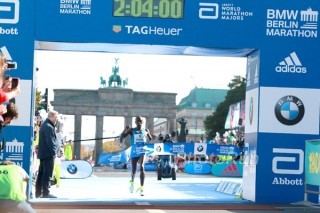
Typically one of the fastest marathons in the world—the world record 2:02:57 by Dennis Kimetto was accomplished here last year— the Berlin Marathon always draws an interest in those seeing just how quick a runner can go in a World Marathon Majors event.
There was no world record in 2015, but Eliud Kipchoge of Kenya turned in a fast time nonetheless, winning in 2:04:00 despite the insoles coming out of his shoes mid-race. Eliud Kiptanui of Kenya was second in 2:05:21. The top American male was Matt Llano with a personal-best time of 2:12:28 to place 13th.
Gladys Cherono of Kenya won the women’s race in 2:19:25, winning by more than a minute over Ethiopia’s Aberu Kebede. Hilary Dionne was the top American female, finishing 19th in 2:34:45.
Here are photos from the race, taken by PhotoRun.net:
Photo Gallery
1 of {count}
Back to Start
View Larger Image

2015 Berlin Marathon
Reid Coolsaet of Canada finished 6th in 2:10:28.
View Larger Image

2015 Berlin Marathon
Vilma Arizapana of Peru finished 18th.
View Larger Image
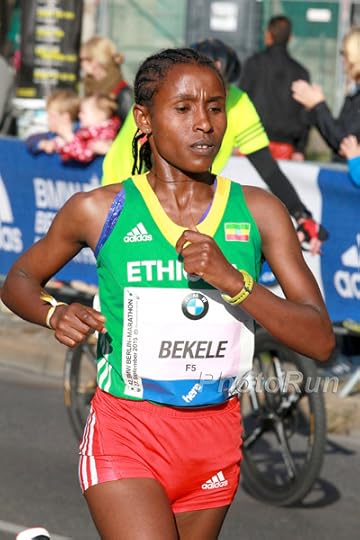
2015 Berlin Marathon
Tadelech Bekele of Ethiopia finished 4th in 2:25:01.
View Larger Image
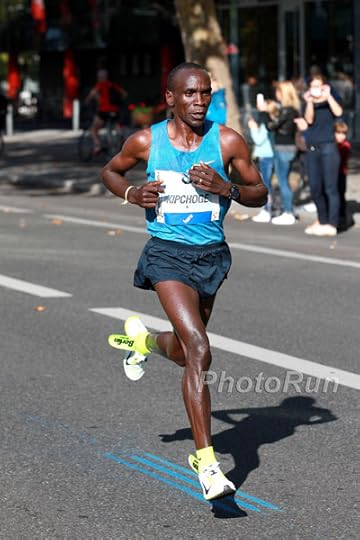
2015 Berlin Marathon
Eluid Kipchoge's shoes were a problem from the beginning, but he never stopped.
View Larger Image
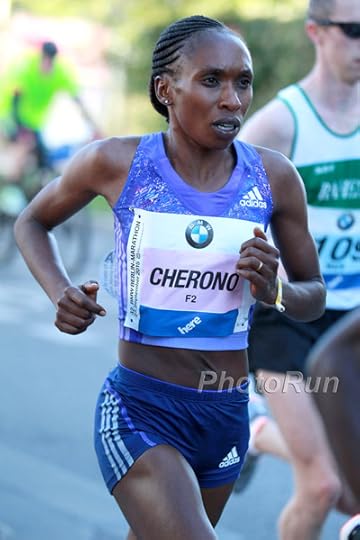
2015 Berlin Marathon
Gladys Cherono of Kenya pulled away to win in 2:19:25.
View Larger Image
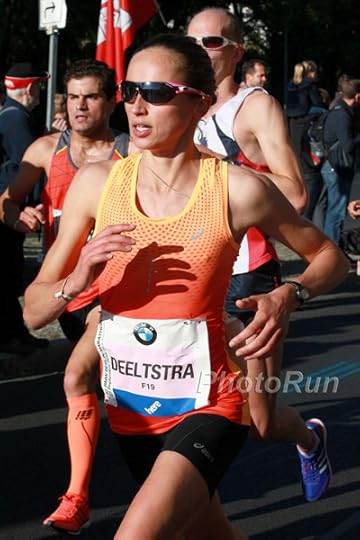
2015 Berlin Marathon
Andrea Deelstra of the Netherlands finished 5th in 2:26:46.
View Larger Image

2015 Berlin Marathon
Kipchoge stayed in front.
View Larger Image
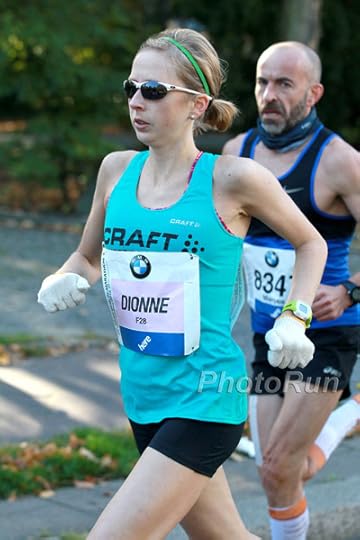
2015 Berlin Marathon
Hilary Dionne was the top American woman.
View Larger Image
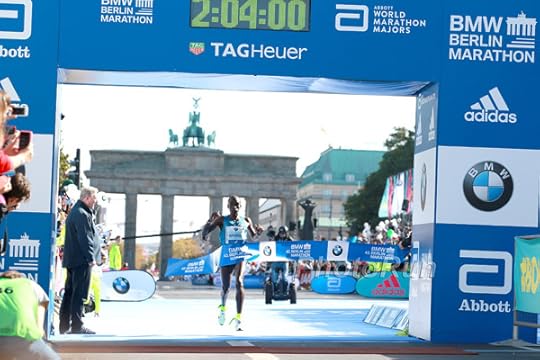
2015 Berlin Marathon
Eluid Kipchoge won in 2:04:00.
View Larger Image
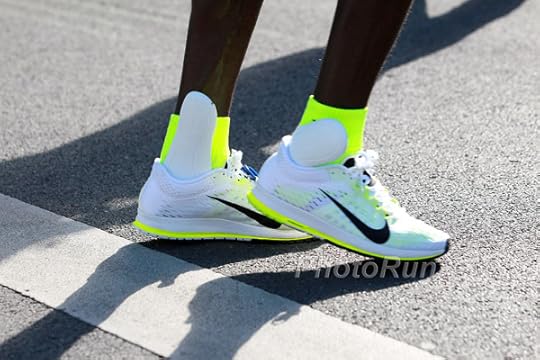
2015 Berlin Marathon
Kipchoge won in 2:04:00 despite the insoles coming out of his shoes for most of the race.
View Larger Image
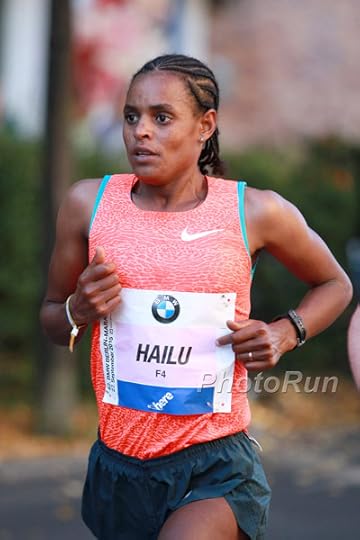
2015 Berlin Marathon
Meseret Hailu of Ethiopia finished third in 2:24:33.
View Larger Image
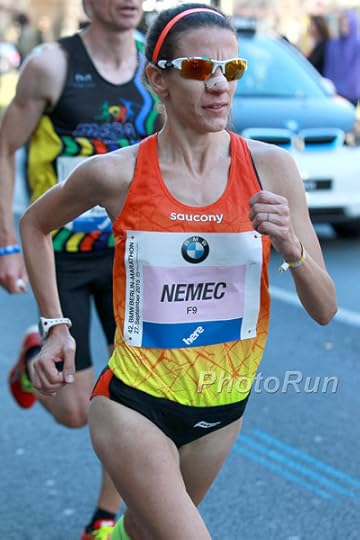
2015 Berlin Marathon
American-born Lisa Nemec, who runs for Croatia, finished 7th in 2:27:57.
View Larger Image
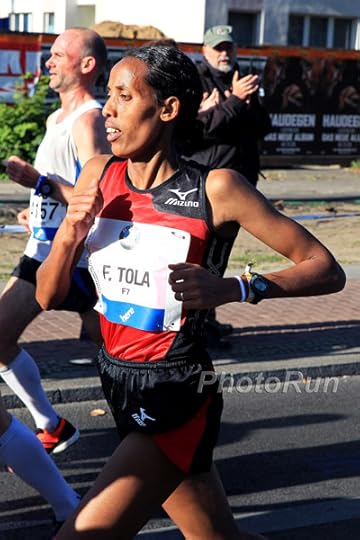
2015 Berlin Marathon
Fate Tola of Ethiopia finished 10th in 2:28:24.
View Larger Image
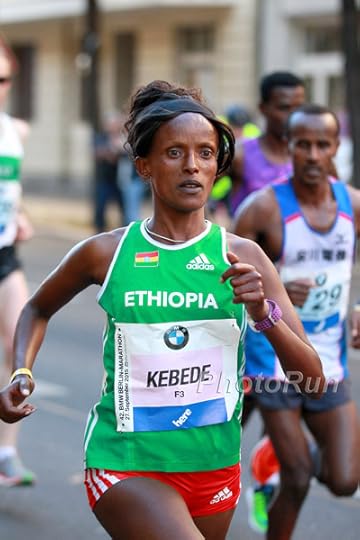
2015 Berlin Marathon
Aberu Kebede of Ethiopia finished second in 2:20:48, some 1:23 behind Cherono.
View Larger Image
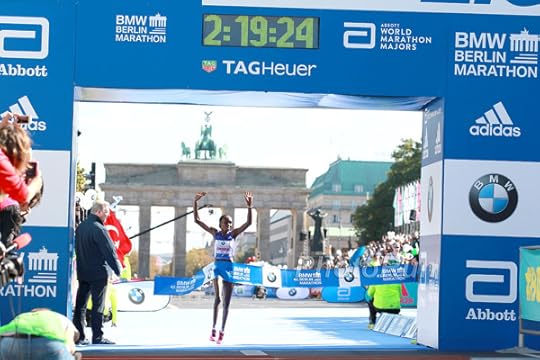
2015 Berlin Marathon
Gladys Cherono crossed in 2:19:25 for the convincing victory.
View Larger Image

2015 Berlin Marathon
View Larger Image
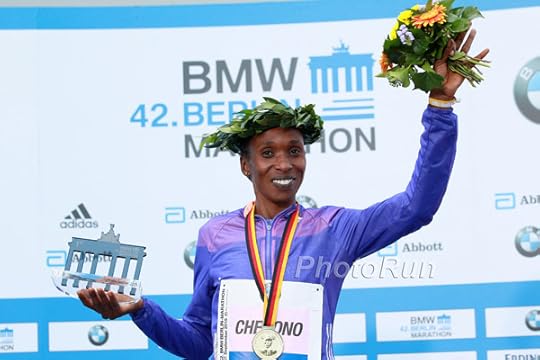
2015 Berlin Marathon
View Larger Image
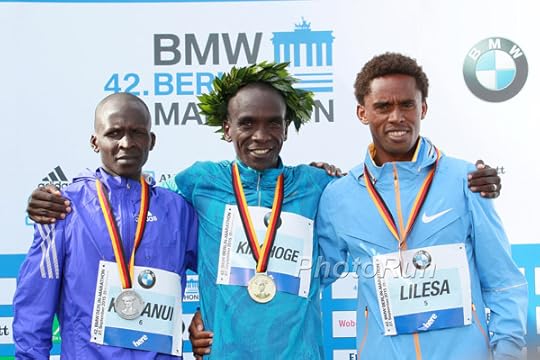
Kiptanui-Kipchoge-LilesaA-Berlin15
The top three men (from left) Eliud Kiptanui, Eliud Kipchoge and Feyisa Lilesa.
View Larger Image
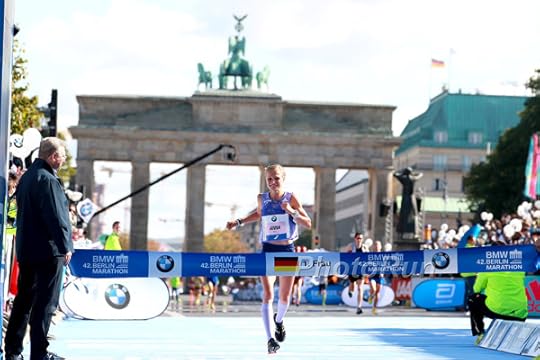
2015 Berlin Marathon
Anna Hahner was the top German, finishing 13th in 2:30:19.
View Larger Image

2015 Berlin Marathon
View Larger Image
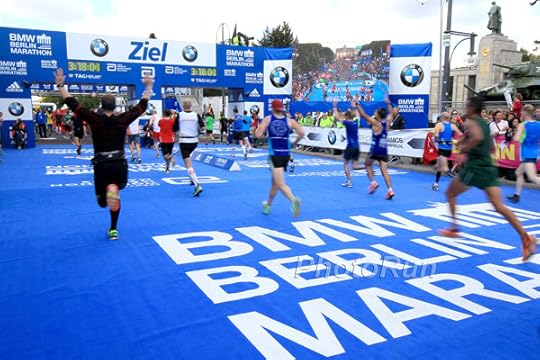
2015 Berlin Marathon
2015 Berlin Marathon
Berlin, Germany September 27, 2015
View Larger Image

2015 Berlin Marathon
View Larger Image
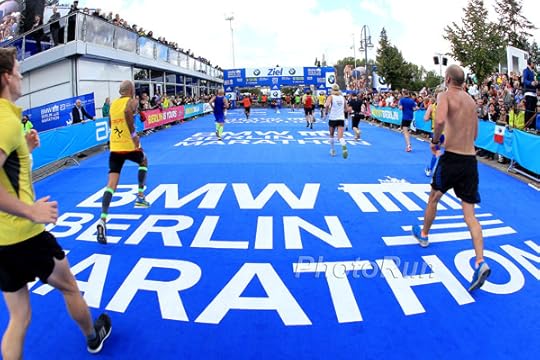
2015 Berlin Marathon
View Larger Image
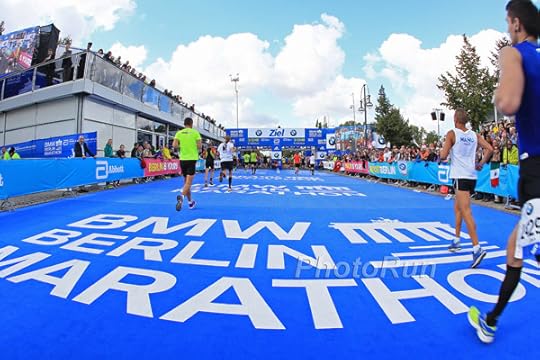
2015 Berlin Marathon
View Larger Image
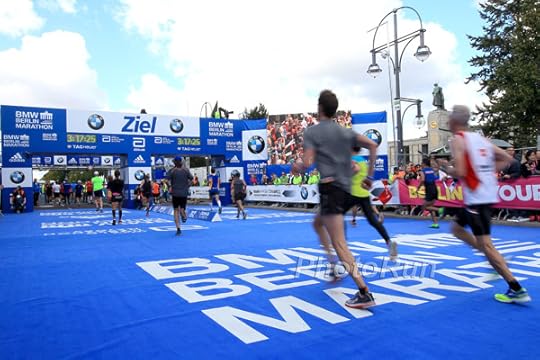
2015 Berlin Marathon
Related Galleries
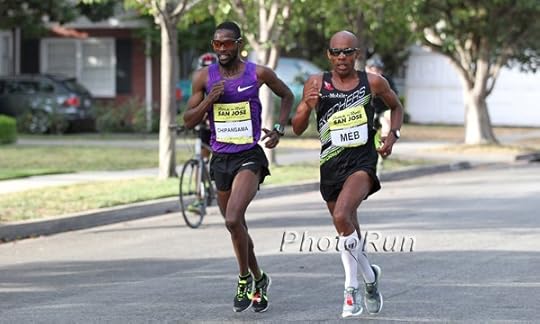
Photos: 2015 Rock ‘n’ Roll San Jose Half Marathon
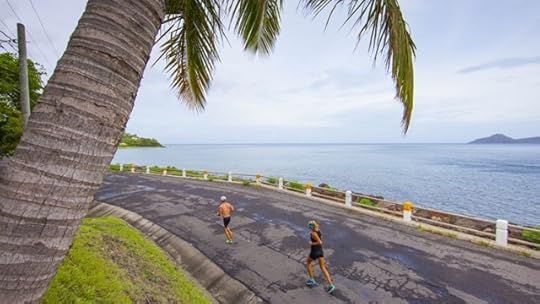
Photos: Caribbean Fun at the Nevis Marathon
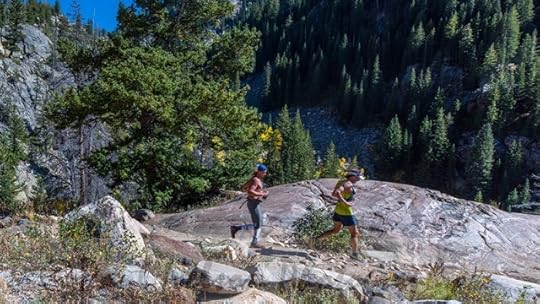
Photos: Colorado’s Run Rabbit Run Trail Races

Photos: Marathon Oasis Rock ‘n’ Roll de Montréal

More Galleries
The post Photos: 2015 Berlin Marathon appeared first on Competitor.com.
RSG to Re-Brand Stores With JackRabbit Name
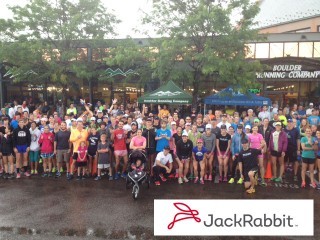
Boulder Running Company is one of the many top-tier running stores RSG bough in 2013 as part of a nationwide roll-up of specialty running stores. It recently said it would re-brand all of its 76 stores under the JackRabbit name and the new JackRabbit logo (inset) in the next 24 months. Photo: Brian Metzler
What’s in a name? Apparently everything for a national chain of running stores. The Running Specialty Group (RSG), a Denver-based subsidiary of The Finish Line Inc., is unveiling a strategic marketing initiative this fall that will eventually entail re-branding all of its 76 specialty running stores in 17 states under the name JackRabbit. The gradual re-branding process will begin with its stores in the New York City area this fall and will continue to other stores over and at JackRabbit.com the next two years.
RSG began purchasing top-performing speciality running stores across the U.S. in 2012 and, with its own expansion of some of those stores, it now operates 76 running shops across the U.S., many of which have been among the most profitable and iconic shops within the running industry. The group currently owns the existing JackRabbit stores in the New York City area, Boulder Running Company stores in Colorado, Blue Mile and Roncker’s Running Spot stores in the Midwest, Raleigh Running Outfitters and Richmond RoadRunner on the East Coast, and numerous others.
It has maintained the branding of many of those stores, but it has also branded some stores with a variation of The Running Company name. For example, several of its Texas stores in the Houston and Austin markets are now branded under the name Texas Running Company. RSG’s original online running shoe sales site was organized at Run.com, but it later switched to a centralized consumer website at BoulderRunningCompany.com. (Run.com currently re-directs to BoulderRunningCompany.com, but the JackRabbit site has been revamped with a new look and logo too.)
RSG announced last week that it will begin its transition to the new branding with an omnichannel approach, which includes a new logo, e-commerce site, an enhanced social presence and “Where FIT Happens” community approach. The transition will occur in six store locations in the New York market in November centered around the New York City Marathon.
“We’re excited to have multiple locations in the region coming together under the JackRabbit brand,” Bill Kirkendall, president of Running Specialty Group said. “JackRabbit is a vibrant and distinctive name that evokes an active lifestyle. It speaks to running enthusiasts, coaches and friends and will elevate our consumer and community experiences at every touch point with a seamless, omnichannel approach.”
RELATED: Running Store Consolidation—What It Means For Runners
“The evolution to JackRabbit will truly take flight within the New York community and we’re excited for this next chapter of our brand story,” said Frank Pruitt, senior vice president of brand strategy and experience at RSG.
JackRabbit activations this November will include a regional in-store and digital campaign surrounding the New York City Marathon with an elevated presence at the health and wellness expo. Following that, the company plans to roll out the JackRabbit brand across the country surrounding key running specialty events over the next 24 months. The new JackRabbit.com will serve as the e-commerce site for all re-branded stores.
”We will continue to invest in all of our stores throughout this rollout to be competitive and relevant to our customers,” Pruitt added. “Through this community-based approach, we will elevate the premium customer experience while incorporating core elements that align with our mission to inspire, connect and serve runners everywhere as they make “FIT” happen every day.”
RELATED: Q&A With Finish Line’s Glenn Lyon And Running Specialty Group’s Bill Kirkendall
The running industry has been closely following RSG’s movements in the past four years, given the amount of leverage it has developed with its growing collection of stores. (RSG has also said it would like to expand its grouping of stores to as many as 200 in the next several years.) There are more than 900 specialty running stores across the U.S., but that level of business has been caught in the crossroads of greater competition from big box sporting goods retailers selling running gear, both small-scale and large-scale retail consolidation at the specialty level, internet sales from new vendors such as Amazon.com and Zappos.com and running shoe brands selling directly from their own online stores.
“To me (branding all of the stores under the JackRabbit name) seems like a convenient way to brand their stores,” says Kris Hartner, owner of independent Naperville Running Company stores in suburban Chicago. “But I’m kind of fan of local naming because it ties into our community and that’s why I have it in the name of my stores. I understand where they’re coming from, but I think it kind of furthers the gap that they have tying back into the local community. If anybody needs a local connection, it’s a national business.”
Hartner says he’s as optimistic as he’s ever been about operating a local running store amid the industry-wide consolidation that’s been happening and competition from online sales. The Naperville Running Company was named the Running Store of the Year in 2009 and 2013 and last year expanded with a second location. Good service, good product and a friendly atmosphere connected to the community are the keys to success, he says.
“I think a lot of people thought there would be a lot of stores closing amid this consolidation, but I don’t think that’s the case,” Hartner says. “Some have closed, but others have opened. From our end, business is good.”
RELATED: Sole Man—Can Independent Specialty Running Stores Survive?
The post appeared first on Competitor.com.
Photos: Red Bull 400 Uphill Race in Park City
On Sept. 26 at the Utah Olympic Park in Park City, Utah, more than 400 hardy athletes and weekend warriors took on the ridiculously difficult challenge of running 400 meters up an Olympic ski jump. Sound hard? Damn straight the Red Bull 400 was hard! The races, co-sponsored by Under Armour, started at the lofty elevation of 6,870 feet above sea level, which only added to the lung and leg burn as competitors ran, crawled and struggled up the 134-meter ski jump landing hill and in-run ramp. As you scroll through the images below, you can almost sense the anguish these competitors put themselves through to reach the top. Turkey’s Ahmet Arslan was fastest of the day, winning the elite heat in 4:05.8 just two seconds ahead of former U.S. Mountain Running Team member John Tribbia of Salt Lake City. U.S. Olympic cross country skier Liz Stephens (4:39.2) was the fastest woman to the top, holding off a hard-charging Austrian cross country skier Veronika Mayerhofer. Proceeds for the event benefitted the local ski jumping and cross country ski programs of the Park City Nordic Ski Club. (View full results online.)
Photo Gallery
1 of {count}
Back to Start
View Larger Image
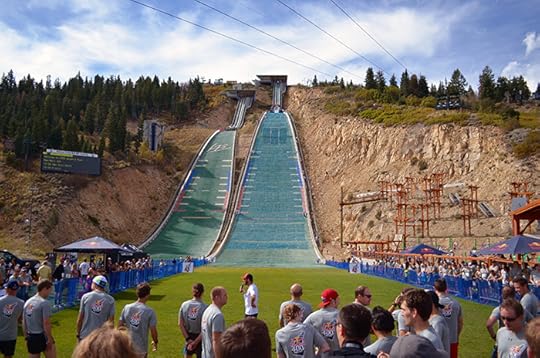
Photo: Susan Lacke Manville
View Larger Image

Photo: Susan Lacke Manville
View Larger Image

Photo: Susan Lacke Manville
View Larger Image

Photo: Susan Lacke Manville
View Larger Image

Photo: Susan Lacke Manville
View Larger Image
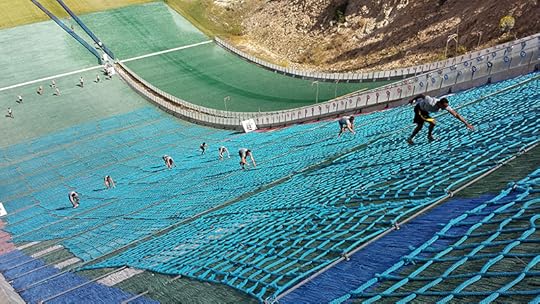
Photo: Susan Lacke Manville
View Larger Image
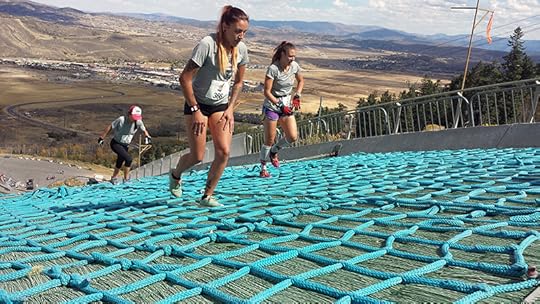
Photo: Susan Lacke Manville
View Larger Image
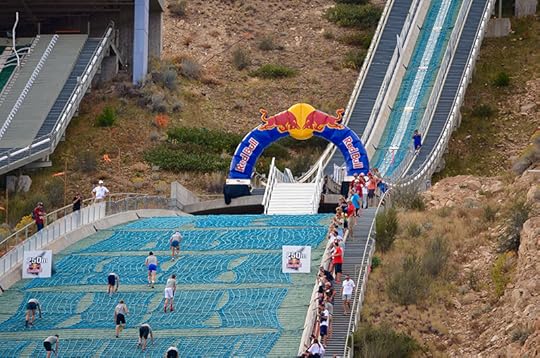
Photo: Susan Lacke Manville
View Larger Image
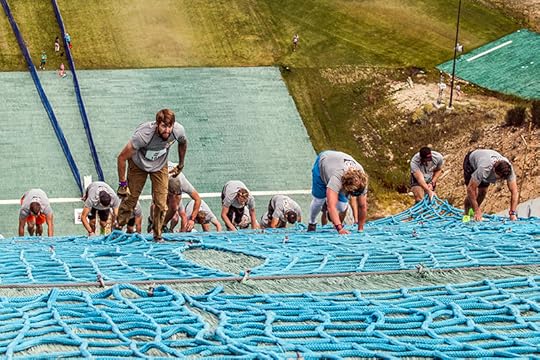
Photo: Courtesy of Red Bull
View Larger Image

Photo: Susan Lacke Manville
View Larger Image
[image error]
Photo: Courtesy of Red Bull
View Larger Image

Photo: Susan Lacke Manville
View Larger Image
[image error]
Photo: Courtesy of Red Bull
View Larger Image
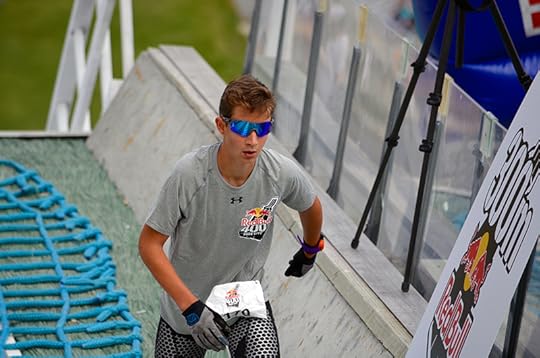
Photo: Susan Lacke Manville
View Larger Image

Photo: Susan Lacke Manville
View Larger Image
[image error]
Photo: Courtesy of Red Bull
View Larger Image
[image error]
Photo: Courtesy of Red Bull
View Larger Image
[image error]
Photo: Courtesy of Red Bull
View Larger Image
[image error]
Photo: Courtesy of Red Bull
View Larger Image
[image error]
Photo: Courtesy of Red Bull
View Larger Image

Photo: Susan Lacke Manville
View Larger Image
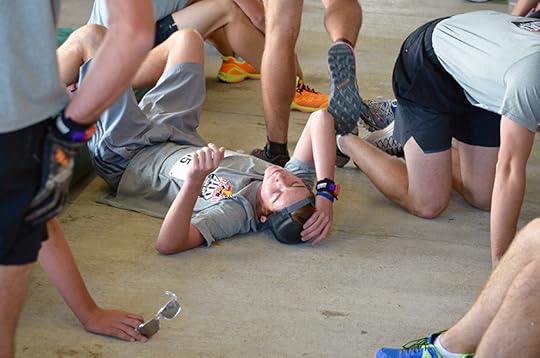
Photo: Susan Lacke Manville
View Larger Image
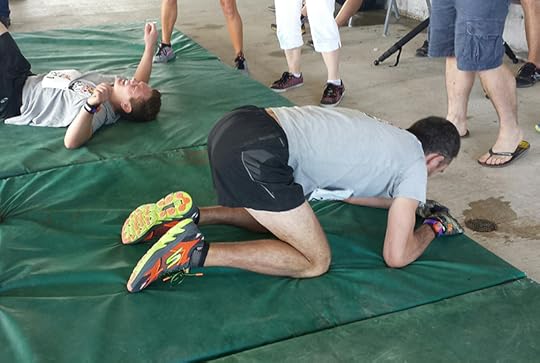
Photo: Susan Lacke Manville
View Larger Image
[image error]
Photo: Courtesy of Red Bull
View Larger Image
[image error]
Photo: Courtesy of Red Bull
Related Galleries

Photos: Vertical Running in Boulder’s Tour de Flatirons
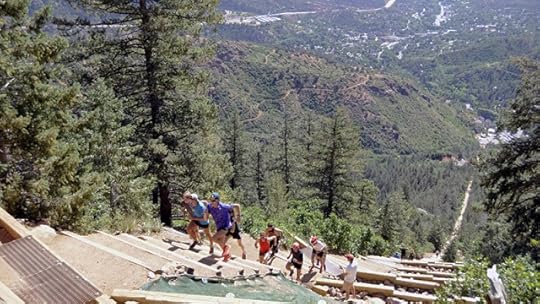
Photos: The Relentlessly Steep Manitou Incline

Photos: Amazing Images from the 2015 Ultra-Trail du Mont-Blanc
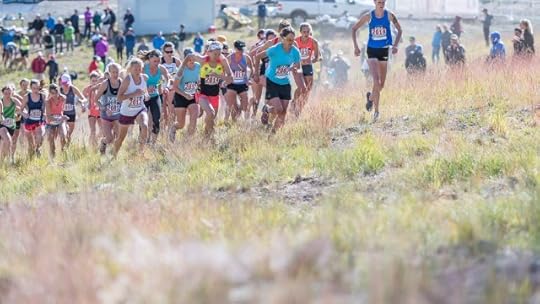
Photos: 2015 U.S. Mountain Running Championships

More Galleries
The post Photos: Red Bull 400 Uphill Race in Park City appeared first on Competitor.com.
September 27, 2015
How Beginner Runners Can Boost Endurance
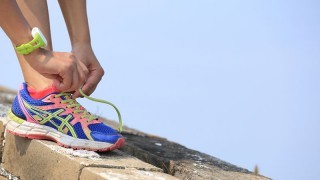
Photo: Shutterstock.com
If a new runner wants to get faster, what’s the best way to improve on their race times?
Surprisingly, beginners should not focus on difficult workouts or faster paces during easy runs.
These training strategies have their place, but new runners are most limited by two factors:
1. Endurance is low since they haven’t been running for long.
2. Injury risks are high.
So to improve, beginners must maximize their endurance while limiting their risk of injury – two goals that are often at odds with one another.
After all, the best way to increase endurance is to run more mileage. But mileage increases are the most common time period for injuries.
Therefore, it’s critical to build endurance in a safer, less risky manner.
Two strategies can be used by beginners to both boost endurance and limit injury risk so they can continue improving.
The post How Beginner Runners Can Boost Endurance appeared first on Competitor.com.
Ryan Hall's Blog
- Ryan Hall's profile
- 21 followers



